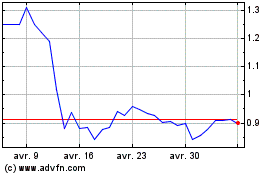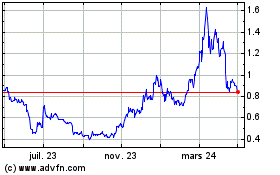US Spot Ethereum ETFs Poised To Draw $1.2 Billion Monthly: Research Firm
22 Juillet 2024 - 5:30PM
NEWSBTC
The US spot Ethereum ETFs are set to launch on Tuesday, July 23rd,
with projections indicating potential monthly inflows of $1.2
billion. This forecast comes from ASXN, a research firm
specializing in crypto finance analytics. US Spot Ethereum ETFs
Could Surprise To The Upside At the core of ASXN’s analysis is the
comparison between the newly introduced Ethereum ETFs and the
previously launched Bitcoin ETFs. One of the critical
differentiators highlighted in the report is the fee structure. The
Ethereum ETFs, while mirroring the fee approach of Bitcoin ETFs,
introduce a notably competitive twist with Grayscale’s new ‘mini
trust’ Ethereum product. Initially disclosed at a 0.25% management
fee, the fee was quickly adjusted to 0.15% after competitive
pressures from other low-fee products like Blackrock’s ETHA ETF.
Grayscale has strategically re-positioned 10% of its Ethereum Trust
(ETHE) Assets Under Management (AUM) to this mini trust, offering
ETHE holders an exchange to the new ETF at no tax liability—a move
aimed at retaining capital within its ecosystem and providing a
more attractive fee structure to fee-sensitive investors.
“Grayscale’s strategic adjustment of its fee structure and the
innovative mini trust offering are likely to redefine the
competitive landscape of Ethereum ETFs,” an ASXN analyst commented
in the report. “This could not only stem potential outflows but
also attract a broader base of institutional investors due to the
more favorable fee dynamics.” Related Reading: Here’s What To Know
On Grayscale Bitcoin & Ethereum ETF Spinoffs – Details ASXN’s
report also covers the potential market impact of the inflow of
funds into Ethereum ETFs. Utilizing global data from existing
crypto Exchange Traded Products (ETPs), the research draws
parallels and contrasts between the Ethereum and Bitcoin markets.
Historically, ETPs have been overweight in Bitcoin relative to
Ethereum based on AUM ratios compared to market cap ratios. This
has shifted slightly with Ethereum gaining more traction and
investment confidence. Referring to other research reports on
potential ETF inflows, the report notes: “There have been many
estimates for the ETF flows, some of which we have highlighted
below. Taking the estimates and standardizing them yields an
average estimate in the $1bn/month region. Standard Chartered Bank
offers the highest estimate with $2bn/month, while JP Morgan is on
the low end at $500m/month.” ASXN’s estimate lies at $800 to $1.2
billion per month. “This was calculated by taking a market cap
weighted average of monthly Bitcoin inflows and scaling this by the
market cap of ETH,” the firm notes. Furthermore, they backed their
estimates with the global crypto ETP data and “are open to an
upside surprise given the unique dynamics of ETHE trading at par
prior to the launch and the introduction of the mini trust.” The
Reflexivity Of ETH In terms of liquidity, the report suggests that
Ethereum’s market dynamics are distinct from those of Bitcoin.
Although Ethereum’s overall liquidity is slightly lower, the impact
of new ETF inflows could be more pronounced due to Ethereum’s lower
‘float’—the amount of an asset readily available for trading.
“Ethereum’s liquidity profile, compounded by its smaller float
relative to Bitcoin, implies that inflows into the ETF could have a
disproportionately positive effect on its price,” states the
report. Related Reading: CBOE Global Markets Lists Spot Ethereum
ETFs, Confirms Launch Date Moreover, ASXN’s analysis is devoted to
the reflexivity inherent in Ethereum’s market. According to the
report, inflows into Ethereum ETFs could lead to higher Ethereum
prices, which in turn could increase activity and investments in
the decentralized finance (DeFi) sector and other Ethereum-based
applications. This feedback loop is supported by Ethereum’s
tokenomics, specifically the EIP-1559 mechanism which burns a
portion of transaction fees, effectively reducing the total supply
of Ethereum over time. “The reflexivity of Ethereum’s market
extends beyond simple supply and demand dynamics due to its
integral role in DeFi and other blockchain-based applications,”
ASXN explains and adds, “as the price of Ethereum increases, it
could significantly enhance the underlying fundamentals of the DeFi
platforms, driving further investments and creating a
self-reinforcing cycle of value appreciation.” The report concludes
with strategic insights for traditional finance (TradFi)
institutions considering Ethereum investments. It argues that the
narrative around Ethereum as a multi-faceted platform for
decentralized applications provides a compelling value proposition
beyond the “digital gold” narrative typically associated with
Bitcoin. ASXN also speculates on the future potential for a staked
ETH ETF, which could attract TradFi players with its
yield-generating capabilities. “The possibility of a staked ETH ETF
could become a game-changer, offering traditional finance a way to
engage with crypto assets that not only appreciate in value but
also generate yield,” the report suggests. At press time, ETH
traded at $3,494. Featured image created with DALL·E, chart from
TradingView.com
Flow (COIN:FLOWUSD)
Graphique Historique de l'Action
De Juin 2024 à Juil 2024

Flow (COIN:FLOWUSD)
Graphique Historique de l'Action
De Juil 2023 à Juil 2024
